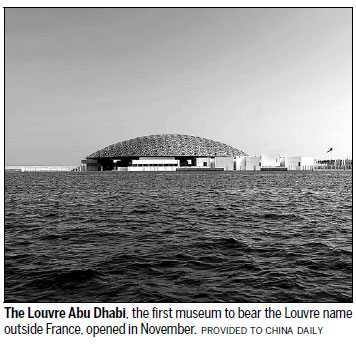Stars shine on architectural masterpiece
By Low Shi Ping in Abu Dhabi | China Daily | Updated: 2018-06-18 10:20

The Louvre Abu Dhabi, a museum in the cultural district of Saadiyat Island, shines among the latest attractions in the United Arab Emirates' capital and it has become a magnet to Chinese visitors.
"The Louvre Abu Dhabi is the UAE's gift to the world," said Mohamed Khalifa Al Mubarak, chairman of Abu Dhabi's Department of Culture and Tourism.
The museum is a sister of the original Louvre Museum in Paris and the first museum to bear the Louvre name outside France, and was designed by the French architect and Pritzker Prize laureate Jean Nouvel, with a graceful nod to its Arabian location.
"The iconic design conceived by Nouvel is an architectural masterpiece," said Saif Saeed Ghobash, director-general of the Abu Dhabi Tourism and Culture Authority.
It rises majestically from the sea, which it is built over, capped by a distinctive dome made up of 7,850 metal stars set in an intricate geometric pattern. It opened in November.
At 180 meters in diameter, the dome covers a large swath of the museum, providing not only shade but an interesting rain of light effect when sunlight pours through it.
The inspiration? The branches of overlapping palm trees ubiquitous in the UAE.
Beneath the dome are 55 blindingly white buildings that make up the various spaces of the museum, including about 6,400 square meters dedicated to the galleries.
While it is not obvious, these are connected and mimic an Arabian medina - the old part of a city - and low-lying settlements once commonly found in the region.
The inaugural exhibition is a chronological narrative of the history of humanity, told through 12 chapters, and draws parallels between concurrent civilizations.
"The museum highlights similarities between seemingly disparate cultures," Saif said.
"Artworks from around the world are displayed side by side, based on shared aesthetics and techniques of production. No other museum in the world has ever taken this approach."
Saif said: "The Louvre Abu Dhabi has already attracted a high number of visitors from China." They are interested in culture and, as a travel industry segment, have become more sophisticated.
"We have several outstanding masterpieces from China on display, which naturally draw interest - including a dragon dress from the 18th century on loan from the Guimet Museum of Asian Art (in Paris) and a winged dragon from the 4th to 3rd century BCE from the Zhou Dynasty (c.11 century-256 BC), among others."
However, enjoyment of the museum does not end with the galleries; it also extends outside. Push through a door in the last exhibition hall and it opens onto a plaza situated beneath the dome. Here its intricacies can be fully appreciated, alongside artworks on display, so the connection to the venue remains strong.
Promenades along the waterfront provide a link to the sea, the breeze bringing cool relief, especially in the summer.
The number of Chinese visitors to Abu Dhabi last year rose 60 percent from 2016, and it will not be a surprise if it increases even more this year.
Saif said a lot of effort has been put into capturing the awareness of Chinese travelers and persuading them to visit Abu Dhabi, starting with the easing of visa restrictions. Chinese visitors now receive visas on arrival.
Other efforts have focused on lowering access barriers by preparing digital platforms, including a website and mobile application, to fully support Mandarin-speaking users.
Saif said a plentiful supply of leisure and entertainment options and high-quality hotels and shopping malls make Abu Dhabi an attractive destination for Chinese.
"We will continue to promote Abu Dhabi's unique offerings focused on presenting the best culturally enriching experiences to Chinese travelers."
Saif is also busy improving Abu Dhabi's tourism offerings, which will help drive traffic from other markets too.
He is growing sectors within the industry, such as cruise tourism, and introducing new segments such as adventure tourism.
"We intend to position the emirate as the leading destination for outdoor activities across the region."
The emirate also has attractions such as the Sheikh Zayed Grand Mosque, ranked the world's second favorite landmark by the travel website TripAdvisor.
The neighboring regions Al Dhafra and Al Ain offer visitors the opportunity to experience Emirati culture and traditions such as falconry, camel races and mangrove tours.
In recent years the Department of Culture and Tourism has focused on bolstering cultural attractions. There is the renovated cultural center Manarat Al Saadiyat, and Abu Dhabi's oldest permanent structure, Qasr Al Hosn, which will reopen at the end of this year after extensive restoration work.
On the northwestern tip of Saadiyat Island the foundations of another museum are being laid, the Guggenheim Abu Dhabi.
"It is being conceived as a pre-eminent platform for contemporary culture and will be joining Louvre Abu Dhabi in the new cultural district," Saif said.
"The museum will be uniquely positioned to examine 20th and 21st century art from truly international perspectives and will also celebrate the specific cultural traditions of the UAE and other countries in the region."
























